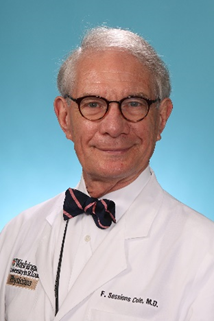
The Robert B. Cotton Lecture was established in 2015 as a tribute to honor the contributions that Dr. Cotton made in the Department of Pediatrics at Vanderbilt University from 1975 to 2014. He served as Chief of the Division of Neonatology from 1989 to 2003 and led the division through a long period of clinical and research growth. His efforts supported the transition to Monroe Carell Jr. Children’s Hospital at Vanderbilt in 2005.
Dr. Cotton's passion for research and discovery inspired a generation of neonatologists and perinatal investigators from around the globe. This endowed lectureship was established to honor the memory of his efforts to improve the lives of the newborns and families we serve.
2024
"Lessons Learned: Epo Neuroprotection"
Sandra Juul, MD, PhD
Professor of Pediatrics
Division of Neonatology
Seattle Children's
Dr. Juul has been principal investigator on two large phase III trials to evaluate Erythropoietin as a neuroprotective agent and is currently leading a trial to decrease transfusions while maintaining iron sufficiency in preterm infants. She is now Director of the Institute on Human Development and Disability as well as the Intellectual and Developmental Disabilities Research Center (IDDRC), which are dedicated to enhancing the lives of individuals with developmental disabilities.
Dr. Juul identified Epo and its receptor in the developing human brain, demonstrated that it is neuroprotective and safe using multiple animal models of neonatal brain injury. Bringing this work from the bench to the bedside, Dr. Juul is currently Principal Investigator of a multicenter randomized controlled trial to determine whether Epo is a safe and effective neuroprotectant for extremely preterm infants. The study, Preterm Epo Neuroprotection (PENUT) is funded by NINDS and has enrolled 940 babies born between 24-0/7 and 26-6/7 weeks of gestation. These children are currently being followed to two years of age for detailed neurodevelopmental assessments. Dr. Juul is also multi-PI with Dr. Yvonne Wu (UCSF) on the High-Dose Erythropoietin for Asphyxia and Encephalopathy (HEAL) Trial, a randomized controlled trial of Epo neuroprotection for 500 term infants with hypoxic-ischemic encephalopathy (HIE). This multicenter trial will determine whether Epo in addition to therapeutic cooling will improve the outcome for infants with HIE.
Most infants navigate seamlessly through the perinatal period. However, as complications around birth are not entirely predictable or preventable, the perinatal period remains the time of greatest potential risk of permanent brain injury or death in the otherwise healthy neonate. The two most prevalent causes of neonatal death and disability globally are prematurity, accounting for 35% of deaths within the first 28 days after birth, and intrapartum related complications. Other than TH, there have been few transformational breakthroughs in neonatal care over the past decades. This is reflected in epidemiologic studies which show that under-5 pediatric deaths decreased by 12% from 2015 to 2021, while neonatal mortality remained relatively stable, only decreasing from 20 to 18 deaths per 1000 live births globally.
An approach to preclinical research is discussed including benefits and downsides of various neonatal animal models. The transition from preclinical to clinical trials is discussed, with key issues to consider. Finally, several recent neonatal trials (PENUT, HEAL and HELIX) are reviewed.
2023
"COVID-19: Is the Placenta a Safe Place?"

Rebecca Simmons, MD
Hallam Hurt Professor in Neonatology
Associate Director, Center for Research, Reproduction and Women's Health
Director, Career Development Core for Center of Excellence in Environmental Toxicology
Deputy Director, Center of Excellence in Environmental Toxicology
Member, Faculty Senate Executive Committee
P.I., March of Dimes Preterm Birth Research Center
University of Pennsylvania School of Medicine
Pregnant patients with COVID-19 are at risk for adverse pregnancy outcomes associated with placental dysfunction, including preterm birth, fetal growth restriction, and hypertensive disorders of pregnancy. Placental infection with SARS-CoV-2 is rare, but multiple inflammatory and metabolic factors are likely to affect the placenta, including circulating extracellular vesicles (EVs) derived from various organs that have been associated with COVID-19 pathology and disease severity. In our studies, we analyzed over 600 placentas from COVID-19 pregnancies and found marked changes in placental morphology, characterized by abnormal maternal and fetal vessels, intervillous thrombi, and fibrin deposition, even in the face of mild or asymptomatic disease. We detected increased levels of small EVs in maternal serum from COVID-19 cases compared to controls and increased levels of mitochondrial DNA in EVs from COVID-19 cases. In in vitro experiments, we found increased oxidative stress in uterine endothelial cells and reduced syncytialization of trophoblast cells following exposure to EVs from pregnant COVID-19 patients.
2022
"Precision in the Selection of Cardiovascular Drugs in Critically Ill Neonates"
Patrick McNamara, MD
Chief, Division of Neonatology, University of Iowa Stead Family Children's Hospital
Professor of Pediatrics and Internal Medicine, University of Iowa
Vice Chair for Inpatient Acute Care Services, Stead Family Department of Pediatrics
The field of Neonatal Hemodynamics is plagued with uncertainty regarding the optimal approach to monitoring, thresholds for therapeutic intervention and optimal approach to selection of cardiovascular drugs. The use of non-validated measures to adjudicate hemodynamic stability and lack of diagnostic precision available to clinicians has led to overreliance on rigid algorithms and a non-judicious approach towards use of cardiovascular drugs. Most clinicians consider a mean blood pressure (BP) below the gestational age equivalent as indicative of hemodynamic compromise; yet this threshold has not been validated. To better understand the relationship of BP to end-organ performance, an integrated and comprehensive approach is needed which incorporates BP, indices of cardiac output, and vascular tone in the context of the primary pathophysiologic disease state. Adjudication of cardiovascular health be cognizant of the vulnerability of the immature cardiovascular system when selecting cardiovascular drugs. Widespread use of targeted neonatal echocardiography is needed to enhance diagnostic precision, appraise underlying physiology (loading conditions and shunt role) and phenotypic characterization of symptom complexes.
2021
"Why do Pediatricians love Oxygen?"

Satyan Lakshminrusimha, MD
Dennis and Nancy Marks Chair
Professor of Pediatrics
Pediatrician-in-Chief
UC Davis Children's Hospital
Oxygen is the elixir of life. It is crucial to dilate pulmonary vasculature and establish lungs as the site of gas exchange. However, starting with Apgar scores, there is a subconscious preference to use higher oxygen levels during the management of neonates, infants and children. It is increasingly evident that hyperoxia is associated with negative clinical outcomes in term and preterm neonates during resuscitation, infants with bronchiolitis and adults with cardiac and respiratory issues. Not providing adequate oxygen can lead to exacerbation of pulmonary hypertension, poor somatic and brain growth and even increase mortality. This talk provided an overview of physiology, clinical evidence and some guidelines for targeting oxygenation in neonates and children.
2020
"Surfactant, Serendipity, and Science: Learning from Rare Diseases"

F. Sessions Cole, III, MD
Park J. White Professor of Pediatrics
Assistant Vice Chancellor for Children’s Health
Executive Vice Chair, Department of Pediatrics
Washington University School of Medicine
Genetic disruption of surfactant metabolism during fetal-neonatal pulmonary transition causes progressive, lethal respiratory failure. In contrast to developmental disruption of surfactant metabolism associated with preterm birth, genetic disruption does not respond to surfactant replacement therapy. Lung transplantation with an estimated 50% 5-year survival remains the definitive treatment for affected infants and children. Rare or private, biallelic variants in the ATP-binding cassette protein A3 gene (ABCA3) are the most common monogenic causes of not only progressive, lethal respiratory failure in term and late preterm infants due to surfactant deficiency but also of childhood interstitial lung disease (chILD). The basis for this phenotypic diversity is unknown, and no effective pharmacologic therapies are available. Using a human pulmonary epithelial cell line (A549) genetically engineered for stable expression of ABCA3 variants and an intact metazoan, Caenorhabditis elegans, we have developed strategies to discover drugs for ABCA3 variant-specific rescue of individual pulmonary phenotypes and investigate the molecular basis of ABCA3-associated phenotypic diversity.
2019
"Prediction of Outcomes in Critically Ill Children"
Namasivayam Ambalavanan, MD
University of Alabama at Birmingham
2018
"Evidence for a Standard of Care: Antenatal Steroids"
Alan H. Jobe, MD, PhD
Cincinnati Children's Hospital, University of Cincinnati
2017
“Steroids and Surfactant and the Preterm Lung: Bench to Bedside and Back Again”
Philip Ballard, MD, PhD & Roberta Ballard, MD
University of California San Francisco
University of Pennsylvania & The Children's Hospital of Philadelphia
2016
“Solving the Puzzle of Preterm Birth: Calendar Event or Immunologic Anomaly”
David K. Stevenson, MD
Lucile Packard Children's Hospital at Stanford/Stanford University School of Medicine
2015
“Patent Ductus Arteriosus: the current treatment conundrum”
Ronald I. Clyman, MD
University of California, San Francisco
